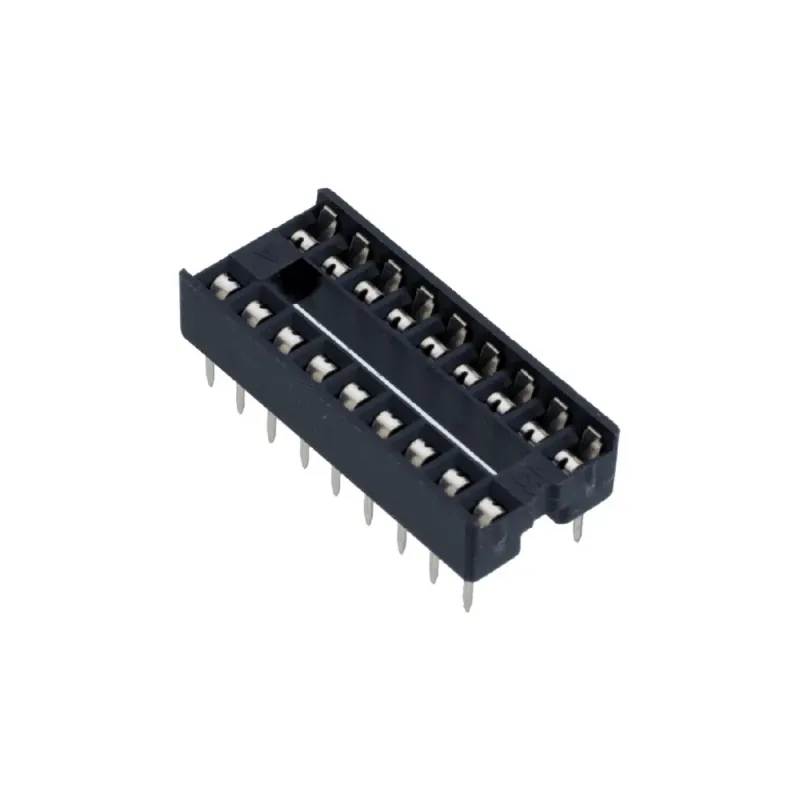
IC Socket 2x9 - DIP 18-Pin Integrated Circuit
0.83RON
- Stock: In Stock
- Model: ICCXXX.DIP18P
Your orders placed until 16:30 on weekdays are shipped on the same day.
2x9 IC - Integrated Circuit Socket 18 Pins DIP-18
Integrated Circuit (IC) sockets serve as connectors that facilitate the easy insertion and removal of ICs from a printed circuit board (PCB). This feature enables the mounting of ICs without the need for direct soldering onto the PCB, which is particularly useful during prototyping, testing, and repair processes.
Key Features:
- Ease of Use: ICs can be conveniently inserted and removed, making them perfect for prototyping and testing.
- Protection: They offer protection to ICs from potential heat damage during soldering.
- Versatility: They come in a variety of sizes and configurations to suit different IC packages.
- Reusability: IC sockets are reusable, facilitating easy replacement of ICs without the need for desoldering.
Types of IC Sockets:
- DIP (Dual In-Line Package) Sockets: These are designed for ICs with two parallel rows of pins and are commonly used in prototyping and development boards. Common pin counts include 8, 14, 16, 20, 24, 28, 40, etc.
- SIP (Single In-Line Package) Sockets: These are used for ICs with a single row of pins and are less common, used for specific types of ICs or modules.
- ZIF (Zero Insertion Force) Sockets: These sockets allow ICs to be inserted and removed without any insertion force. A lever or cam mechanism is used to secure the IC. They are ideal for testing and programming where frequent IC changes are required.
- PLCC (Plastic Leaded Chip Carrier) Sockets: These are designed for PLCC IC packages, which have leads on all four sides. Common pin counts include 20, 28, 32, 44, 52, 68, etc. They are commonly used in applications requiring high pin counts.
- BGA (Ball Grid Array) Sockets: These are used for ICs with an array of solder balls on the bottom and are used in high-density, high-performance applications like CPUs and GPUs.
- PGA (Pin Grid Array) Sockets: These are used for ICs with an array of pins arranged in a grid pattern. They are common in older CPU sockets and some high-power applications.
Benefits of Using IC Sockets:
- Flexibility: They allow for easy swapping of ICs for testing or upgrading.
- Damage Prevention: They protect ICs from thermal stress and potential damage during soldering.
- Maintenance: They facilitate easy replacement of faulty ICs without the need for desoldering.
- Prototyping: They are crucial in development and prototyping environments where ICs may need frequent replacement.
Drawbacks:
- Additional Cost: They add to the overall cost of the PCB design.
- Increased Height: They add to the height of the PCB, which may be an issue in compact designs.
- Potential for Poor Contact: Over time, the contacts in the socket can wear out or become unreliable.
Applications:
- Prototyping and Development: They allow for easy swapping of ICs during the design and testing phases.
- Repair and Maintenance: They facilitate easy replacement of faulty ICs in electronic devices.
- Educational Kits: They are used in educational kits and development boards for their ease of use and versatility.
- Production: In some instances, they are used in low-volume production where frequent updates or changes are expected.
Conclusion:
IC sockets are indispensable components in the electronics realm, offering flexibility, protection, and ease of use. They are vital in prototyping, testing, and scenarios where ICs need to be frequently replaced. Despite the additional cost and increased height, the advantages they provide often outweigh the drawbacks, making them a preferred choice in various applications.
Package Includes:
1 x IC Socket 2x9














